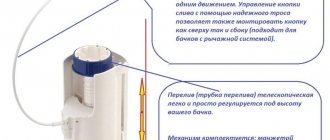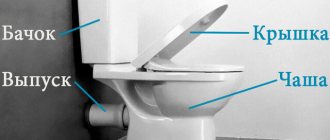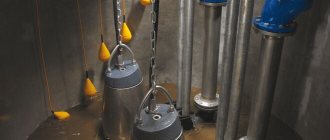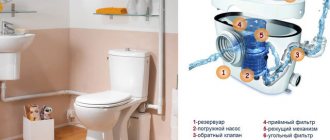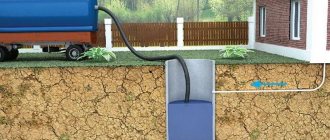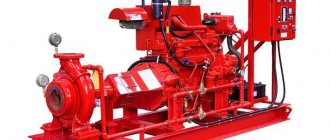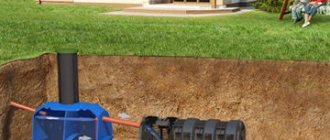Poor location of utilities can derail plans for creating a convenient layout. Everyone is accustomed to the fact that there are standards regulating the distance from the sewer riser to the toilet and other plumbing fixtures. Therefore, bathroom owners had to put up with the current state of affairs.
Only after a special toilet pump appeared, it became possible to place the equipment anywhere in the house. Agree, the device can be very useful, especially for rooms of non-standard shapes and dimensions.
Let's figure out what kind of miracle device this is, what its design and principle of operation are. In addition, we offer a detailed overview of different units, an algorithm for their selection and installation. Such information will be a godsend for those who are planning to buy and install a toilet grinder.
What is forced sewerage
The standard internal sewer system of a private or apartment building is designed according to the gravity principle. This means that wastewater from the toilet and other plumbing fixtures is directed by gravity or “gravity” into the sewer riser.
For the smooth operation of the system, certain conditions are required: a correctly calculated distance from the toilet to the riser, the required slope of the pipeline, and more.
Pumps with a grinder are compact equipment that allows you to install forced sewerage in any conditions
If they are disturbed, the flow rate slows down and blockages appear. To prevent such a situation, forced sewerage is used. To install it, a pump is installed in the system, the main function of which is the forced supply of wastewater into the pipeline.
A pump with a grinder, sometimes called a sololift, also grinds large inclusions present in the wastewater.
The device is compact, but at the same time has quite high power. It is capable of draining wastewater up to 5-7 m in the vertical direction and up to 100 m in the horizontal direction. The height of wastewater rise is especially important when it is planned to install a bathroom located below the sewer level.
The small size of the sololift allows it to be placed behind the cistern or even placed inside the latter.
Image gallery
Photo from
Purpose of installing a sanitary pump with grinder
Prerequisites for using a fecal pump
The principle of using a fecal pump
Versatility of use of sewage plants
Design and principle of operation of a pump with a chopper
A standard pump of this type is a system for pumping liquids enclosed in a plastic housing, equipped with blades for crushing large inclusions. The device must be connected to sewerage and power supply systems.
The chopper is usually installed in the upper half of the pump housing. After the wastewater enters the container with the blades, solid inclusions are retained here, and the liquid passes further.
The figure shows a diagram of a sanitary pump with a toilet grinder (+)
Depending on the device model, two options are then possible. If the device is equipped with a float switch, the mass will accumulate to a certain volume. In other cases, the shredder will start immediately.
In any case, after the blades are activated, they begin to cut the inclusions, turning them into a homogeneous mass, which the pump will push to the sewer riser.
On sale you can find models where the chopper is located under the pump. It must be admitted that such devices work less efficiently, since due to the design features of the blades, they do not grind solid inclusions well enough.
This is worth considering when purchasing a device. The pump must be equipped with a check valve that prevents the return of wastewater.
Inside the container there is a cutting unit equipped with metal knives. Its task is to grind large inclusions in wastewater. The resulting mass is pushed to the sewer riser
Principle of operation
The fecal pump for the toilet is installed in the bathroom behind the toilet. The connection is made to the drain using a pipe. It is through the latter that the contaminated liquid is pumped out.
The pumping equipment is turned on and the knife grinder, which grinds flushed waste, is started automatically, immediately after flushing the toilet. As soon as the water in the tank reaches a certain level, the pump turns off, throwing water through the pipe into the drain hole.
To prevent various kinds of troubles during drainage, a check valve is provided. It is located inside the pump and helps to avoid situations such as overflow of drains when filling the cesspool.
Why do you need such a pump at all?
It must be admitted that the use of a pump allows you to solve the most complex issues in the arrangement of a sewer system. These include moving the toilet to almost any distance from the riser, installing plumbing in a room located below the sewer level, and much more.
The undeniable advantages of using pumps are:
- Effectively prevent blockages in the sewer system. Due to the fact that the drains inside the pipes are pushed and do not move by gravity, they do not have the opportunity to accumulate and form traffic jams.
- Possibility of using small diameter pipes for arranging a sewer system.
- Less water consumption from the cistern.
- Possibility to place plumbing equipment anywhere in the apartment.
In addition, pumps with grinders operate almost silently, especially those models that use high-quality insulation. They do not create discomfort and do not interfere with rest at night.
There are also certain inconveniences associated with the operation of the devices. The devices are volatile, so they can only function if electricity is available, which may not always be possible in a country house, for example.
Sanitary pumps are quite compact and are placed right behind the toilet. The figure shows a standard arrangement of the device
In addition, the pumps must be serviced regularly. Namely, to clean them. Depending on the model, this will have to be done manually or using special chemical solvents.
If this is not done, the device may become clogged, which will immediately affect its operation. However, there are also self-cleaning models that do not require cleaning, but their cost is slightly higher.
Information about pumps for arranging forced sewerage in a private house is presented in the articles:
- Sewage pumps: types, how to choose correctly + operating features
- Domestic sewer pumping stations: types, design, installation examples
Types of equipment
The industry produces several types of toilet pumps. Each of them has a specific area of application and operating features. Let's look at the devices in more detail.
Devices for cold waste
Designed to work with liquids whose temperature does not exceed 40°C. It must be borne in mind that some elements of equipment may become unusable from contact with hot wastewater.
Therefore, under no circumstances should they be connected to the drain of a bathtub or shower. There are two types of such devices. One of them assumes the presence of a chopper, the second does not.
The former can be used both for toilets only and for combined connections, which may include a sink, bidet, toilet, etc. The latter cannot be used to work with toilets.
Moreover, when using them, it is necessary to monitor the drains so that large inclusions do not get into the pump. To install the devices, special adapter couplings are used, which are also sensitive to high temperatures.
On sale you can find sanitary pumps designed to be placed inside the cistern. These can be models designed for pumping both hot and cold waste water
Devices for hot waste
The equipment can function normally when pumping wastewater whose temperature does not exceed 90°C. However, this value may vary depending on the purpose and model of the device. It should be clarified in the technical documentation of the device. Such pumps are designed to work with a wide variety of household appliances.
Those that can pump not very hot liquids are used when connecting a bath or shower.
Image gallery
Photo from
Sanitary pumps for pumping hot wastewater
Sanitary installation for working in a hygienic room
Equipment connected to sanitary pumps
Availability of a grinder in sewage pumps
More expensive devices that can withstand temperatures up to 90°C can work with a washing machine or dishwasher. Like cold waste units, these pumps can be with or without a grinder.
The first option is used to arrange a comprehensive connection for a toilet, bathtub, washing machine, etc. The second can only be used if there is no toilet among the connected devices.
Pumps with grinders for hot wastewater are somewhat different from their “cold” counterparts. Their cutting parts are more durable and are designed to grind even fairly hard and small-sized inclusions.
The design features of these devices are such that objects that cannot be cut settle to the bottom of the shredder mesh and remain there until the next cleaning of the device, without affecting its operation at all.
Special compact types of sanitary pumps are produced especially for wall-hung toilets. They are mounted behind a decorative panel near the installation or directly on it
Compact type devices
For small bathrooms and toilet rooms, compact toilet grinders are ideal. These devices are similar to standard pumps, differing from them only in their small sizes.
The width of the body of such devices rarely exceeds 12 cm, which makes it possible to install it behind a decorative panel or in a small niche directly on the installation on which the toilet will be mounted.
Toilet with built-in pump: new plumbing product
Relatively recently, unusual plumbing equipment appeared on sale, which is a toilet with a built-in grinder and pump. The equipment can be distinguished from standard analogues by its appearance - it does not have a drain tank.
The device simply does not need this part, since the toilet is connected directly to the water supply and when you press the flush button, water is supplied directly from the main line.
At the same moment, the chopper is also activated. True, for the device to operate correctly, a certain level of pressure in the water supply is required. The minimum value is 1.7 atm.
The equipment is equipped with additional sewer outlets, which allows you to connect several more plumbing fixtures to it: a sink, a bidet, a washing machine or a bathtub.
A toilet with a built-in pump with a grinder is very convenient and practical. The device can be placed at any distance from the sewer riser (+)
A toilet with a grinder has many advantages:
- Connects directly to the water supply.
- The built-in drain mechanism makes the presence of a conventional tank unnecessary.
- Effective drainage of wastewater up to 30 m in the horizontal direction and up to 3 m in the vertical direction.
- Compact dimensions make the device ideal for small spaces.
- The productivity of the device is 85 l/min.
- Additional insulation allows the equipment to operate virtually silently.
- No complex maintenance required.
- The device is more reliable and safe than a standard toilet with a connected grinder.
- Full compliance with Russian and European sanitary standards.
The device is very reliable and efficient. Its main disadvantage today is the high cost, which is due to the fact that the manufacturer is just beginning to produce such equipment.
To avoid errors when calculating the power of the device, you can use this diagram. It shows the dependence of the distance of movement of wastewater on the height of its rise
Popular models
We invite you to familiarize yourself with the most popular models of toilet pumps with a grinder for forced sewage, used for installation in bathrooms.
SFA Sanicompact Elite
The modern sewage installation SFA Sanicompact Elite is a toilet that has a compact grinder pump for forced sewerage built into its body. Additionally, any plumbing fixture can be connected to the pump. For example, washbasin, shower, bidet.
The photo shows the SFA Sanicompact pump in the interior
The device operates in two modes:
- Grinding and pumping the contents coming from the toilet. The mode is turned on by pressing the button located on top of the toilet. The duration of the switching cycle is 25 seconds, after which the pump automatically turns off;
- Pumping water from another plumbing fixture. The pump starts working automatically, and the duration of its operation directly depends on the volume of wastewater.
Specifications:
- power - 0.8 kW;
- temperature of the pumped substance - up to 35 degrees;
- vertical rise of wastewater – up to 3 m;
- horizontal wastewater pumping - up to 30 m;
- water consumption - about 3 liters per 1 cycle of operation;
- the diameter of the pipes used is 32 mm;
- installation weight - 26.5 kg;
- Dimensions - 360 x 490 x 555 mm.
Its cost is from 33,000 rubles.
SFA Sanitop Silence
The price for this silent toilet grinder pump is quite affordable. It comes from its purpose. The device is connected directly to the toilet, which has a horizontal outlet. The body of the device has an additional hole for supplying waste from the washbasin. The pump is installed on the floor behind the toilet and secured to the floor. The device is equipped with a removable check valve and a carbon filter that serves to eliminate unpleasant odors.
SFA Sanitop Silence
Specifications:
- temperature of the pumped substance - up to 35 degrees;
- vertical rise of wastewater - up to 5 m;
- horizontal wastewater pumping - up to 100 m;
- the diameter of the pipes used is 23-32 mm;
- power - 0.55 kW;
- productivity - 6 cubic meters/hour;
- weight - 5.1 kg;
- Dimensions - 330 x 163 x 263 mm.
The price for this sewer grinder pump for a toilet bowl will be approximately 18,000 rubles.
Jemix STP 100
This is a combined sewer pump model designed to grind waste and remove it from the toilet, shower cabin, and washbasin. It is possible to connect all of the listed plumbing fixtures to the pump simultaneously. The device is capable of pumping cold and hot wastewater. The pump is installed on the floor, behind the toilet. Only suitable for toilets with horizontal outlet. The device is equipped with a set of plugs for all inputs.
Jemix STP 100
Technical characteristics of the device:
- the temperature of the wastewater passing through the device is up to 90 degrees;
- vertical rise of wastewater - up to 7 m;
- horizontal wastewater pumping - up to 70 m;
- the diameter of the pipes used is 40 mm for the shower and washbasin and 100 mm for the toilet;
- power - 0.6 kW;
- productivity - 127 l/min;
- weight - 9 kg;
- pump dimensions - 163 x 263 x 330 mm.
The price for this sewer pump for the toilet is much lower than the models described above - 9,500 rubles.
Plus, we also recommend that you pay attention to the Sololift line of pumps from the Danish manufacturer Grundfos.
Important Features of Shredder Pumps
On sale you can find a fairly wide range of pumps with grinders for toilets. Their differences are quite significant, so before purchasing a device you need to know exactly its purpose and determine the conditions in which it will work. Otherwise, the money will be wasted.
As practice shows, when choosing the right device, the following characteristics must be taken into account.
Fecal pump power
The manufacturer indicates it in the technical documentation attached to each device. Expressed in meters, it shows the distance over which the device can move wastewater. Usually two indicators are indicated: height and moving distance.
On average, the device can lift wastewater upward by 10 m and move it horizontally by 100 m. You need to understand that these are the maximum possible indicators.
Therefore, if they exactly coincide with the required operating parameters, it is better to choose equipment with a “reserve”. After all, if he has to constantly work at maximum power, any additional load, even short-term, will disable him.
In addition, constant operation “at the limit of capabilities” will significantly reduce the life of the equipment.
One more nuance. You need to understand that the indicators specified in the technical documentation are in some way mutually exclusive. This means that if the pump has to lift the drains up to the maximum height, then it will no longer be able to move them to the distance specified in the passport.
Practice shows that on average, every meter of wastewater rise reduces the distance of its horizontal transportation by approximately 10 m.
If there are several plumbing fixtures nearby, it is recommended to purchase a so-called combined pump model, which involves connecting several devices at once
Number of possible connections
The manufacturer produces various models of devices. Some of them are designed to work with only one plumbing fixture, in this case a toilet, while the rest can be classified as combined equipment.
They can connect to multiple devices. This is relevant for bathrooms in which several appliances require forced sewerage.
In this case, it is optimal to purchase a pump with a grinder, install it on the toilet and connect the rest of the equipment to it. When choosing such a model, it is important that the pump is equipped with a sufficient number of outputs for connection, and that its power is sufficient to service all devices.
If there are many plumbing fixtures, it may be appropriate to install two pumps.
Image gallery
Photo from
Selecting a sewage pump for several connection points
Sewage pump with two connection points
Sewage equipment with three pipes
Compliance with the installation distance of the sanitary pump
Frequency of waste disposal
There are two modifications of pumps with grinders for toilets. The first option is equipped with a float-type switch. In this case, the shredder blades are started only after a certain volume of solid waste has accumulated. Thus, the device first accumulates wastewater.
The second type of device activates the shredder after each press of the drain button.
A pump with a float switch activates the shredder much less frequently, which helps extend the life of the device.
In addition to the above-described characteristics of the equipment, when choosing, you must pay attention to the dimensions of the sewer pipe. If they do not coincide with the cross-section of the pump inlet pipes, you will need to additionally purchase a special adapter.
In addition, it is important to choose the right system performance and decide on the type of toilet. The last important point is the temperature of the wastewater, which determines the type of pump.
What brands should you take a closer look at?
Fecal pumps for toilets equipped with grinders are produced by different manufacturers. According to consumer reviews, the products of such companies are trustworthy: German Grundfos , French SFA and Chinese JEMIX .
The SFA brand appeared in the middle of the last century and became widely known for the production of high-quality pumping equipment. The manufacturer offers a wide range of household appliances.
Among them are both grinder pumps and combined devices designed for simultaneous operation with several plumbing fixtures: bathtub, sink, shower cabin, etc.
The company produces a large number of compact models designed for installation in a cistern. The housings of the devices are made of high-strength plastic, which significantly extends their service life.
The models are distinguished by their thoughtful design and compactness, making them ideal for installation in confined spaces.
Grundfos devices are easy to install and operate. Their additional advantage is the low noise level that the devices emit during operation.
The JEMIX company produces a line of pumps called STP .
It includes six models with different technical characteristics, including combined appliances and one toilet with a built-in grinder. All devices are quite powerful and can be used for both horizontal and vertical movement of wastewater.
Toilets with a built-in pump are easily recognized by the absence of a flush tank and the presence of a wire connecting the equipment to the network
DIY pump installation
For work you will need a drill, an adjustable wrench, pliers and a building level. The cross-sections of the outlet hole and drain pipe must be the same. Installation is carried out in 3 stages:
- Sewer pipe connection.
- Connecting the pipe to the gravity system.
- Connecting the device to the outlet pipe of the chopper.
Pipes must be installed in such a way as to avoid sharp and right angles of rotation, otherwise the additional load may cause premature failure of the equipment. They are connected to the gravity system through a special tee.
The chopper is connected through a corrugation. It is also important to avoid strong bends and turns. The inlet of the grinder container should be located below the toilet outlet.
Connection to the electrical network is carried out last.
Some home owners, trying to avoid corners when connecting the pump, are ready to use pipes of a larger diameter than originally planned. This is not necessary, because a correctly selected model will fully cope with the load even with a small pipe diameter
Installation video instructions
You can get acquainted with the features of installing a toilet with a grinder pump using the example of installing a compact model:
The most difficulties arise when determining the technical parameters of a suitable toilet pump model.
If you can’t choose on your own, seek help from sales consultants at plumbing stores, or even better, from specialists.
A competent plumber will help you select and install the pump himself. The correct model and high-quality installation are a guarantee of long, uninterrupted service of the toilet and the entire sewer system as a whole.
Sewage pump connection procedure
Before starting installation, you should determine the location where the device will be installed. There are some rules here. First of all, it is strictly forbidden to place the pump below floor level.
The equipment must be located directly next to the toilet, at a distance of no further than 0.4 m. It is necessary to ensure free access to the device so that maintenance and repair work can be carried out without difficulty.
You should once again make sure that the diameters of the sewer pipe and the pump inlet pipe match. If not, purchase an adapter. In addition, a check valve must be installed at the pump outlet.
If it is not there, an extremely unpleasant situation cannot be ruled out when wastewater from the sewer rushes into the toilet. A check valve may be included with the pump, but if not, you will need to purchase it in addition.
Before installation, you should carefully read the instructions that come with the device. It is optimal for it to be in Russian. The document describes in detail the installation process of the selected model.
In addition, the instructions are always accompanied by all the necessary diagrams and illustrations. Check the package again to make sure that all parts and fasteners necessary for installation are present.
Some models of sanitary pumps are equipped with carbon filters that eliminate unpleasant odors. They must be changed regularly, otherwise the device will not function effectively.
After preparation for installation is completed, you can begin the installation procedure. It is carried out as follows.
Step #1. First, we insert supply pipes or connecting elbows into all inlet pipes of the pump. We make sure that the highway approaches the device at a slope of 3 cm per linear meter. This will allow the wastewater to move by gravity to the device, which is necessary for its normal operation.
If there are more inputs than are currently required, we place plugs of suitable size on the “non-working” holes.
Step #2 . We install the pump in a pre-selected and prepared place. We find special cast lugs for fasteners on the product body, insert screws into them and secure the pump to the floor. We begin laying the pipeline from the pump to the sewer riser.
It is optimal for the pipes to run straight; turns should be avoided or, if this is not possible, they should be made as flat as possible. If there are joints between pipes, soldered, welded or adhesive joints are made. Their quality must be high so that leaks do not appear later.
If the pump will have to lift wastewater upward and a vertical outlet will be installed, it should be located at a distance of no more than 0.3 m from the outlet pipe of the device. Only in this case will the device be able to function normally.
Step #3 . We connect the pipe coming out of the toilet with the pump - we use corrugation to fix the elements. In this case, it is imperative to arrange the connection so that the inlet pipe of the pump is located lower than the outlet pipe from the toilet. In addition, the necessary slope for the drain pipe should be provided so that the drains move by gravity.
The toilet grinder pump is energy dependent and therefore requires connection to the electrical network. For safety reasons, this should only be done through an RCD.
Step #4. Ventilation arrangement. This procedure is necessary for models without a carbon filter, the design of which includes a special ventilation outlet. The pipe must be installed above the ridge on the roof of the house.
If this seems like too much trouble, you should choose a model with a replaceable carbon filter that will trap all unpleasant odors. But in this case, the cartridge will have to be changed regularly.
Step #5 . Electrical power must be supplied to the pump. For models with a plug, you will need to install an individual socket, the cable to which is laid from the RCD and the panel. If the device does not have a plug, the connection is made directly from the mains via a 30 mA RCD.
After this, you can conduct a test run of the device. During the procedure, you should carefully inspect the joints of the elements for leaks and troubleshoot problems, if any.
